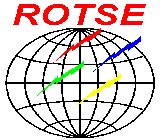 |
Project Information
|
| The Robotic Optical Transient Search Experiment (ROTSE) is dedicated to observation and detection of optical transients on time scales of seconds to days. The emphasis is on gamma-ray bursts (GRBs), the most powerful explosions in our Universe. The ROTSE equipment is quite modest by the standards of modern optical astronomy but the wide field of view and the fast response permit measurements inaccessible to more conventional instruments. This Web site is devoted to describing our science objectives, the instruments for obtaining data, the techniques for extracting significant information and, finally, some of our conclusions. In the process, we hope to give the visitor a chance to glimpse some of our activities at close hand. |
 Principle Investigator Carl Akerlof University of Michigan |
|
To carry out our program, ROTSE telescopes were installed
around the world at several remote locations
including Los Alamos, New Mexico, Coonabarabran, Australia and
Mt. Gamsberg, Namibia. This permits continuous observations of the
night sky, 24 hours per day. The ROTSE project is a collaboration of
astrophysicists from the University of Michigan, Los Alamos National
Laboratory, Lawrence Livermore National Laboratory, the University of
New South Wales (Australia), and the Max Planck Institute for Nuclear
Physics (Germany). Funding has been provided by NASA, NSF, The
Research Corporation, and the Australian Research Council.
Learn more about the world-wide extent of the ROTSE project. Learn more about the science of Gamma-Ray Bursts | |

Recent EventsROTSE-IIIa in Australia: the system is running normally. ROTSE-IIIb in Texas: the system is running normally. ROTSE-IIIc in Namibia: the camera chip came detached from its backing, and the camera is currently in San Diego for repair. We hope to have it returned to Namibia within the next two weeks. ROTSE-IIId: Eli Rykoff and Carl Akerlof are at Bakirlitepe right now. The system has been made operational, although there are certainly birthing pains. Weather has been only partially cooperative. However, first light has been achieved, and hopefully the system will be fully automatic within the next week. | |

There is also more information about the ROTSE Collaboration | |